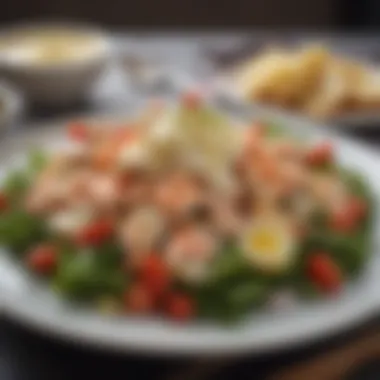Explore the Best Foods with Fat Free Mayonnaise


Intro
Fat-free mayonnaise occupies a unique place in contemporary culinary practices. It serves as a healthier alternative to traditional mayonnaise, appealing to those who prioritize nutrition without sacrificing flavor. This article explores the best foods that harmonize well with fat-free mayonnaise, providing innovative pairing ideas, nutritional insights, and culinary techniques. By focusing on its versatility, the content caters to health-conscious individuals as well as culinary enthusiasts seeking to enrich their dishes.
Understanding how to utilize fat-free mayonnaise effectively can transform a range of recipes. Not only does it add creaminess, but it also enhances flavors while keeping calorie intake in check. The upcoming sections will delve deeper into various recipes, ensuring that readers gain a comprehensive understanding of how to incorporate this ingredient into their meals.
Recipe Overview
Recipe Name and Description
One standout application of fat-free mayonnaise is in creating a refreshing Fat-Free Coleslaw. This dish combines shredded cabbage, carrots, and a tangy dressing that maintains flavor while cutting down on calories. The addition of fat-free mayonnaise ensures a creamy texture, elevating this classic side dish.
Cuisine Type
This recipe draws from American cuisine, renowned for its comforting dishes and hearty salads. Coleslaw is often associated with barbeques and gatherings, making it an appealing dish for various occasions.
Ingredients List
Detailed Ingredient Breakdown
- 1/2 medium green cabbage – finely shredded
- 1 medium carrot – grated
- 3/4 cup fat-free mayonnaise – the star ingredient
- 2 tablespoons apple cider vinegar – adds tanginess
- 1 tablespoon honey or sugar – for a hint of sweetness
- Salt and pepper – to taste
Substitutions for Dietary Needs
This coleslaw recipe can be made suitable for various dietary needs. For gluten-free versions, ensure all ingredients are certified gluten-free. If you need a vegan option, substitute fat-free mayonnaise with a plant-based alternative. Additionally, you can replace honey with agave nectar to accommodate vegan preferences.
Fat-free mayonnaise opens the door to a plethora of culinary possibilities, enhancing dishes while keeping them nutritious. The following sections will continue to explore further recipes, allergen considerations, and practical applications of this versatile ingredient, aiming to educate readers on its benefits and uses in everyday cuisine.
Preface to Fat Free Mayonnaise
In recent years, fat free mayonnaise has gained significant attention within the culinary world. This product offers a healthier alternative to traditional mayonnaise, appealing to those seeking to reduce their fat intake while still enjoying creamy textures and flavors. Understanding fat free mayonnaise is crucial because it allows individuals to make more informed decisions in their cooking and meal preparation.
Definition and Composition
Fat free mayonnaise is a condiment made from a mixture of water, egg whites, vinegar or lemon juice, and various stabilizers. Unlike its full-fat counterpart, it contains little to no fat. It is often formulated with additional ingredients to maintain a similar texture and taste. Common components may include modified food starch or xanthan gum, which help create the creamy consistency that people expect from mayonnaise. The lack of fat significantly reduces the caloric content, making it an attractive option for those on calorie-restricted diets.
Nutritional Benefits
The primary advantage of fat free mayonnaise is its lower calorie and fat content. For example, a tablespoon of traditional mayonnaise can contain around 100 calories and 11 grams of fat, while fat free mayonnaise often contains only 15 to 20 calories with nearly no fat. This reduction makes it easier to incorporate mayonnaise in various dishes without overwhelming daily caloric limits.
Furthermore, fat free mayonnaise still retains some essential vitamins and nutrients, especially if made with enriched ingredients. Some brands fortify their products with omega-3 fatty acids or added vitamins, providing further nutritional benefits. However, it is essential to pay attention to sugar and sodium content, as some varieties may include additional sweeteners or preservatives to enhance flavor.
Culinary Applications of Fat Free Mayonnaise
Fat-free mayonnaise serves a dual purpose in the culinary realm: enhancing flavors while maintaining a lighter nutritional profile. Its creamy texture provides a versatile base for many dishes. This section will explore the diverse application of fat-free mayonnaise, highlighting its role in dips and spreads, salad dressings, and sandwich fillings. By understanding these applications, food enthusiasts can better incorporate this ingredient into their cooking.
Dips and Spreads
Dips are an essential part of appetizers and snacks. Fat-free mayonnaise can transform simple ingredients into rich, creamy dips. The base flavor can be elevated by adding various ingredients. For instance, mixing fat-free mayonnaise with garlic, herbs, and spices can create a delectable garlic herb dip.
- Classic Veggie Dip: Combine fat-free mayonnaise with ranch seasoning for a crowd-pleasing choice. This pairs well with carrot sticks, celery, and bell peppers.
- Spicy Hummus Variation: Blend fat-free mayonnaise with chickpeas, garlic, and tahini for a light yet creamy hummus alternative. This dip retains much of the traditional flavor without added calories.
Dips made with fat-free mayonnaise often have a smooth texture, appealing to those looking for healthier snack options.
Salad Dressings


Incorporating fat-free mayonnaise into salad dressings is another clever way to enhance meals. Traditional dressings often rely on oil for richness. By opting for fat-free mayonnaise, individuals can significantly cut down on calories without sacrificing flavor.
- Creamy Vinaigrette: Mixing fat-free mayonnaise with vinegar and a splash of mustard creates a tangy, fibrous dressing, perfect for pairing with leafy greens or roasted vegetables.
- Cucumber Salad Dressing: Use fat-free mayonnaise as a base, introducing yogurt, dill, and lemon juice for a refreshing dressing that complements cucumber salads well.
Not only does it offer a pleasing texture, but it also binds the ingredients harmoniously in various salads.
Sandwich Fillings
When it comes to sandwiches, fat-free mayonnaise can be the secret ingredient. The base can elevate flavor and moisture without the heaviness of traditional options. Consider its uses in different sandwich varieties:
- Classic Chicken Salad: Combine shredded chicken, celery, grapes, and fat-free mayonnaise for a delightful filling. This sandwich option is nutritious and easy to prepare.
- Tuna Salad: Mixing canned tuna with fat-free mayonnaise, diced onions, and relish results in a flavorful filling that is lower in calories. Serve it on whole grain bread for a balanced meal.
Incorporating fat-free mayonnaise into sandwich fillings offers a lighter alternative while still allowing for satisfying meals.
Incorporating fat-free mayonnaise into meals not only enhances flavors but also contributes to healthier culinary practices.
By understanding these applications, cooks can explore the flexible nature of fat-free mayonnaise in the kitchen. The culinary possibilities are extensive, making it a valuable component for health-conscious individuals and gastronomes alike.
Best Foods to Combine with Fat Free Mayonnaise
The combination of fat-free mayonnaise with other foods is a topic deserving attention because it harmonizes flavor and texture while maintaining a health-conscious approach. Understanding how to best use fat-free mayonnaise can enhance not just the taste profile but also the nutritional aspect of meals. Its creamy texture serves as an excellent base for numerous dishes, allowing various ingredients to shine through. As we explore the best foods to pair with fat-free mayonnaise, we should consider not only the flavor compatibility but also the added health benefits they offer.
Vegetables
Raw Vegetable Dippers
Raw vegetable dippers provide an appealing way to enjoy the crunch and freshness of vegetables alongside the creamy nature of fat-free mayonnaise. This dish encourages the consumption of vegetables, which are rich in vitamins and fibers. The key characteristic of raw vegetable dippers is their simplicity and vibrant presentation, making them an enticing option for appetizers or snacks.
One of the unique features of raw dippers is their ability to carry flavors without overpowering them. This makes them a popular choice for health-conscious individuals. Using fat-free mayonnaise as a dip encourages more vegetable consumption, crucial for a balanced diet. However, it is important to ensure that the vegetables are freshly sourced to maximize taste and nutritional value.
Roasted Vegetable Salads
Roasted vegetable salads elevate the humble vegetable into a hearty dish. When combined with fat-free mayonnaise, they transform into a creamy salad that can serve as a main course or side. The roasting process caramelizes the natural sugars in the vegetables, enhancing their flavors. This dish is beneficial because it combines cooked and raw components, creating a complex texture.
The versatility of roasted salads is one of their defining traits. They allow for a wide variety of vegetables, from squash to carrots, thus catering to different tastes and preferences. However, be wary of over-roasting, which may lead to a mushy texture, diluting the salad's overall appeal.
Proteins
Chicken Salad Variations
Chicken salad variations are one of the quintessential uses of fat-free mayonnaise. This dish not only adds protein but also introduces numerous flavor possibilities. Swapping regular mayonnaise for the fat-free version significantly reduces the caloric intake, making it a smart choice for those watching their weight. The key characteristic of chicken salad is its adaptability to different palates, whether you prefer spices, fruits, or nuts.
The unique feature of chicken salad lies in its capacity to incorporate various ingredients. You can mix fruits like grapes or apples for sweetness. However, overcomplicating the salad can dilute the flavors, so balance is crucial.
Fish and Seafood Dishes
Fish and seafood dishes are another excellent pairing for fat-free mayonnaise. This inclusion can enhance flavors without adding excessive fat. Fish such as tuna or salmon jazzed up with fat-free mayonnaise can create a delightful sandwich filling or a flavorful salad. The key characteristic here is functionality; fat-free mayonnaise adds richness while preserving the dish's integrity.
A unique aspect of fish-inspired dishes is that they can be made quickly and offer abundant nutrition. They provide essential omega-3 fatty acids. On the downside, not all seafood pairs well with the texture of fat-free mayonnaise, so careful selection is needed to maintain harmony in the dish.
Grains and Breads
Grain Bowls
Grain bowls have emerged as a trendy yet nutritious meal option. When paired with fat-free mayonnaise, they create creamy bases that bind various ingredients. The key characteristic of grain bowls is their versatility, as they can be customized based on seasonal ingredients or personal preferences. They enable you to combine healthy grains like quinoa or brown rice with vegetables and proteins.
The unique feature of grain bowls is how they can serve as a complete meal. They encompass a variety of textures and flavors. However, keeping the balance of ingredients is vital; an overabundance of mayonnaise can make the bowl soggy, detracting from its overall appeal.


Wraps and Sandwiches
Wraps and sandwiches represent an easy way to incorporate fat-free mayonnaise. They allow for convenience and portability, while still offering a plethora of combinations. The key aspect of using fat-free mayonnaise in wraps is its ability to moisten without overwhelming. The creaminess can enhance taste while keeping calories in check.
Unique to wraps and sandwiches is their ease of assembly, making them ideal for quick meals. However, filling them too much can lead to structural collapse, so ensure to use the right amount for both flavor and stability.
Recipe Ideas Featuring Fat Free Mayonnaise
Incorporating fat-free mayonnaise into recipes can significantly enhance flavor and texture while providing a healthier alternative to traditional mayonnaise. This section offers a curated collection of recipe ideas that utilize fat-free mayonnaise as a key ingredient. Each recipe showcases its versatility in various culinary applications, providing a practical guide for both seasoned cooks and novices.
Creamy Coleslaw
Creamy coleslaw stands out as a refreshing side dish, especially in warmer months. By substituting regular mayonnaise with fat-free mayonnaise, one can achieve the same creamy texture while drastically reducing the calorie count.
Ingredients:
- 4 cups of shredded cabbage
- 1 cup of grated carrots
- 1/2 cup of fat-free mayonnaise
- 2 tablespoons of apple cider vinegar
- 1 tablespoon of sugar
- Salt and pepper to taste
Preparation:
- In a large bowl, mix the shredded cabbage and grated carrots.
- In a separate bowl, whisk the fat-free mayonnaise, apple cider vinegar, sugar, salt, and pepper until well combined.
- Pour the dressing over the cabbage mixture and toss to coat evenly.
- Chill in the refrigerator for at least 30 minutes before serving.
This creamy coleslaw pairs well with grilled meats and sandwiches. Additionally, the inclusion of fat-free mayonnaise adds a tangy richness without excessive fats.
Classic Tuna Salad
Tuna salad is a meal that is both quick and nutritious. The usual mayonnaise can be swapped for fat-free mayonnaise to reduce calories while keeping the dish satisfying.
Ingredients:
- 1 can of tuna in water, drained
- 1/4 cup of fat-free mayonnaise
- 1 tablespoon of Dijon mustard
- 1/2 cup of chopped celery
- 1/4 cup of chopped onion
- Salt and pepper to taste
Preparation:
- In a medium bowl, combine the drained tuna, celery, onion, and fat-free mayonnaise.
- Add Dijon mustard, salt, and pepper, mixing until well incorporated.
- Serve on whole-grain bread, in a wrap, or over a bed of mixed greens.
Using fat-free mayonnaise keeps this classic dish light yet flavorful, making it a great option for lunch or a snack.
Lemon Garlic Chicken
Lemon garlic chicken is a simple yet flavorful dish that benefits from a marinade incorporating fat-free mayonnaise. The mayonnaise helps to tenderize the chicken while imparting moisture.
Ingredients:
- 4 boneless, skinless chicken breasts
- 1/2 cup of fat-free mayonnaise
- Juice of 2 lemons
- 4 cloves of minced garlic
- 1 teaspoon of dried oregano
- Salt and pepper to taste
Preparation:
- In a bowl, mix fat-free mayonnaise, lemon juice, minced garlic, oregano, salt, and pepper.
- Coat the chicken breasts in the marinade and let it sit for at least 1 hour.
- Grill or bake the chicken until cooked through, approximately 20-25 minutes.
This recipe provides a tasty and moist chicken dish that can be served with vegetables or grain for a balanced meal. The use of fat-free mayonnaise not only offers a lower-calorie option but also enhances the overall taste.
In summary, these recipes highlight the culinary versatility of fat-free mayonnaise. With its creamy texture and ability to blend into various dishes, it becomes an ally for health-conscious cooks looking for flavorful alternatives.
Health Considerations


Understanding the health implications of fat-free mayonnaise is crucial for anyone looking to enhance their diets while maintaining a mindful approach to nutrition. This section will delve into various aspects of health related to using fat-free mayonnaise. The discussion will focus on caloric reduction, which is a principal advantage for individuals trying to manage their weight. Additionally, we will explore allergen considerations, offering inclusive options like egg-free and soy-free varieties, essential for those with specific dietary restrictions.
Caloric Reduction
One prominent benefit of fat-free mayonnaise is its significantly lower caloric content compared to traditional mayonnaise. This reduction is appealing for individuals aiming to decrease their overall calorie intake without sacrificing flavor or texture in their dishes. For example, a tablespoon of fat-free mayonnaise typically contains about 15 calories, whereas the same serving of regular mayonnaise can exceed 90 calories.
The capability to create wholesome, satisfying meals while keeping calorie counts low makes fat-free mayonnaise an asset in many culinary settings. Users can enjoy creamy textures in salads, dips, or spreads without the guilt of excessive caloric intake. Moreover, this feature aligns well with numerous dietary goals, such as weight management and overall healthy eating.
Potential Allergens
The versatility of fat-free mayonnaise extends beyond flavor and calories; it also addresses potential allergens in various diets. This is particularly relevant for those who may have allergies to key ingredients commonly found in traditional mayonnaise. Two primary categories warrant attention: egg-free options and soy-free varieties.
Egg-Free Options
Egg-free mayonnaise alternatives provide a crucial solution for individuals with egg allergies or those adhering to vegan diets. The key characteristic of this option is that it replaces eggs with plant-based ingredients. Common substitutes include aquafaba, which is the liquid from canned chickpeas, or other emulsifying agents derived from plants.
Using egg-free mayonnaise is a beneficial choice as it allows everyone to enjoy creamy dressings and dips without the risk of allergic reactions. The unique feature of egg-free mayonnaise is its ability to mimic the texture and richness of traditional mayonnaise while remaining entirely plant-based. This component allows for a wider array of culinary applications, from salads to sauces, appealing to health-conscious consumers seeking to avoid eggs.
Soy-Free Varieties
Soy-free mayonnaise is another noteworthy alternative in the world of fat-free options. Many individuals avoid soy due to allergies or sensitivities. This option typically substitutes soy with other emulsifiers that maintain the desired creamy texture. The key characteristic of soy-free varieties is their potential to be made from wholesome ingredients like sunflower oil or other non-soy-based oils.
This type of mayonnaise is popular among those seeking to diversify their dietary choices while still achieving satisfying flavors in their dishes. The unique feature of soy-free mayonnaise lies in its versatility for various dietary needs, all while maintaining the essence of traditional mayonnaise. Choosing soy-free options enables individuals to participate in culinary experiences without compromising their health preferences.
The use of fat-free mayonnaise can be tailored to meet diverse dietary needs, showcasing its adaptability and promoting inclusivity in food preparation.
Fat Free Mayonnaise in Popular Diets
Fat free mayonnaise has gained attention among various dietary regimens. Its versatility can align with health goals while enhancing flavors in meals. This section will explore how fat free mayonnaise integrates into low-carb, keto, and plant-based diets, addressing benefits and considerations for each.
Low-Carb and Keto
For individuals following a low-carb or ketogenic diet, fat free mayonnaise provides a strategic alternative to traditional condiments. Regular mayonnaise, while rich in healthy fats, can contribute to a higher caloric intake, something dieters may seek to avoid. Thus, fat free mayonnaise allows for indulgence without the significant carbohydrate load.
Integrating fat free mayonnaise into these diets can be done through various applications. It works well in dressings or dips, perfect for pairing with low-carb vegetables.
Some notable benefits include:
- Low Caloric Content: Allows for additional foods without exceeding daily limits.
- Flavor Enhancer: Maintains the taste profile while cutting calories.
- Protein Pairing: Complementary with high-protein foods like grilled chicken or tuna.
Plant-Based Diets
Fat free mayonnaise serves as an effective substitute for traditional mayonnaise in plant-based diets. Its formulation typically omits eggs, catering to those who follow vegan diets. Plant-based eaters can enjoy creamy textures in their dishes without compromising their dietary principles.
The incorporation of fat free mayonnaise in plant-based recipes opens avenues for creativity. It enhances the flavor and texture of salads, sandwiches, and various spreads. Benefits of using it in plant-based diets include:
- Alleviation of Dietary Restrictions: Offers a safe option for those with egg allergies.
- Versatile Ingredient: Works well in multiple culinary applications, from dressings to spreads.
- Support for Nutritional Needs: Provides moisture in recipes that might otherwise be dry.
Culmination
Fat free mayonnaise stands as a remarkable ingredient in modern cooking. Its benefits extend beyond its lower calorie count, impacting nutritional choices and culinary creativity. This article has thoroughly explored the various ways in which fat free mayonnaise enhances dishes, demonstrating its importance in a variety of contexts.
Recap of Advantages
Fat free mayonnaise offers numerous advantages that make it a valuable addition to any kitchen. One primary benefit is its caloric reduction, which makes it an appealing choice for those looking to maintain a healthier diet without sacrificing flavor. Its creamy texture enhances dishes without contributing to the saturated fats often present in traditional mayonnaise. Some additional advantages include:
- Versatility: It can be used in dips, dressings, and more without compromising taste.
- Nutritional Benefits: Often fortified with essential nutrients, providing both flavor and nutrition.
- Convenience: Easily incorporated into recipes, saving preparation time.
- Diet Compatibility: Suitable for those on low-carb or plant-based diets, expanding dietary options.
Final Thoughts on Culinary Versatility
The culinary versatility of fat free mayonnaise is expansive. It plays a significant role in enhancing flavors and textures in various dishes. From salads to sandwiches, this ingredient allows for creativity while still adhering to health-conscious principles. The myriad of recipe options, embellished by fat free mayonnaise, can transform simple meals into gourmet experiences.
As food lovers continue to seek out healthier alternatives without sacrificing taste, fat free mayonnaise remains a relevant staple. When used thoughtfully, it opens the door to culinary innovation, making it a must-have for the modern kitchen.















